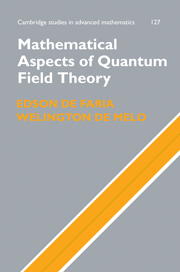Book contents
- Frontmatter
- Contents
- Foreword
- Preface
- 1 Classical mechanics
- 2 Quantum mechanics
- 3 Relativity, the Lorentz group, and Dirac's equation
- 4 Fiber bundles, connections, and representations
- 5 Classical field theory
- 6 Quantization of classical fields
- 7 Perturbative quantum field theory
- 8 Renormalization
- 9 The Standard Model
- Appendix A Hilbert spaces and operators
- Appendix B C* algebras and spectral theory
- Bibliography
- Index
6 - Quantization of classical fields
Published online by Cambridge University Press: 05 March 2013
- Frontmatter
- Contents
- Foreword
- Preface
- 1 Classical mechanics
- 2 Quantum mechanics
- 3 Relativity, the Lorentz group, and Dirac's equation
- 4 Fiber bundles, connections, and representations
- 5 Classical field theory
- 6 Quantization of classical fields
- 7 Perturbative quantum field theory
- 8 Renormalization
- 9 The Standard Model
- Appendix A Hilbert spaces and operators
- Appendix B C* algebras and spectral theory
- Bibliography
- Index
Summary
In this chapter, we describe the basic ideas of the quantum theory of fields. The greater portion of this chapter is devoted to understanding the quantization of free fields. The theory of free quantum fields can be treated in a mathematically precise, axiomatic way, as shown by Wightman. The (constructive) theory of interacting quantum fields is at present not so well developed. But we do discuss scattering processes in some detail at the end of the chapter. From a physicist's standpoint, such processes are extremely important, because they provide a link between quantum field theory and the reality of laboratory experiments.
Quantization of free fields: general scheme
As we saw in Chapter 2, to perform the quantization of a harmonic oscillator we need to factor the Hamiltonian as a product of two mutually adjoint operators: the particle annihilator operator, which lowers the energy level of the Hamiltonian, and the particle creator operator, which raises the energy level. These two operators completely describe the spectrum of the Hamiltonian. The basic physical idea behind the quantization of the classical free fields (Klein–Gordon, Dirac, Maxwell) is the following. Because the Lagrangians of these fields are quadratic, the corresponding Euler–Lagrange equations are linear PDEs. Therefore we can use the Fourier transform to diagonalize the quadratic form in the Lagrangian, thereby decoupling the Euler–Lagrange equations
In the case of the Klein–Gordon equation, corresponding to scalar bosons, each Fourier mode is a harmonic oscillator that is quantized as described above.
- Type
- Chapter
- Information
- Mathematical Aspects of Quantum Field Theory , pp. 117 - 152Publisher: Cambridge University PressPrint publication year: 2010



